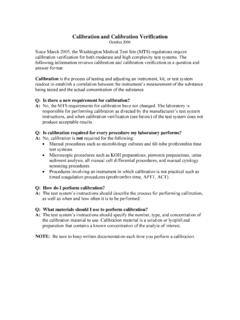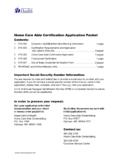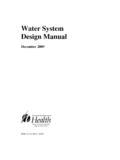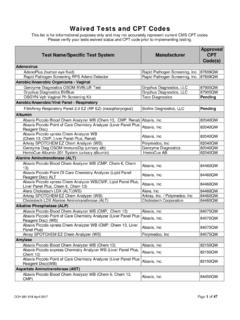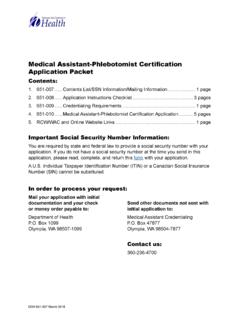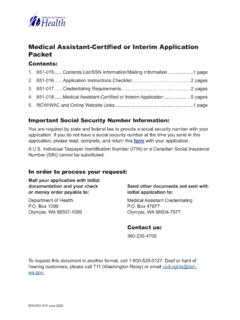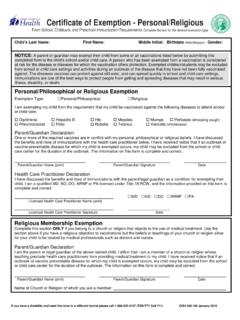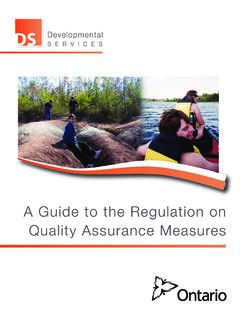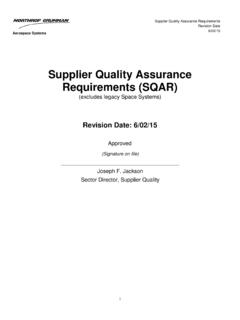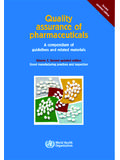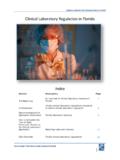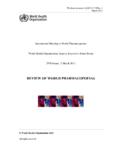Transcription of Nursing Care Quality Assurance Commission …
1 NCQAC Advisory Opinion Standing Orders and Verbal Orders Page 1 of 4 For persons with disabilities, this document is available on request in other formats. To submit a request, call 1-800-525-0127 (TDD/TTY 711) Department of Health Nursing care Quality Assurance Commission Advisory Opinion The Nursing care Quality Assurance Commission (NCQAC) issues this advisory opinion in accordance with WAC 246-840-800. An advisory opinion adopted by the NCQAC is an official opinion about safe Nursing practice. The opinion is not legally binding and does not have the force and effect of a duly promulgated regulation or a declaratory ruling by the NCQAC.
2 Institutional policies may restrict practice further in their setting and/or require additional expectations to assure the safety of their patient and//or decrease risk. Title: Standing Orders and Verbal Orders Number: NCAO References: RCW Nursing care WAC 246-840 Practical and Registered Nursing Nursing Scope of Practice Decision Tree RCW Epinephrine Auto injectors (EPI Pens)-School Supply-Use Contact: Deborah Carlson, MSN, RN Phone: 360-236-4725 Email: Effective Date: September 12, 2014 Supersedes: Not Applicable Approved By: Nursing care Quality Assurance Commission Conclusion Statement The NCQAC concludes that nurses may follow standing orders to carry out medical regimens under the direction of an authorized provider (physician and surgeon, dentist, osteopathic physician and surgeon, podiatric physician and surgeon, physician assistant, osteopathic physician assistant, advanced registered nurse practitioner, or licensed midwife).
3 This would also include the ability to delegate to credential or non-credentialed unlicensed assistive personnel (UAP) to implement standing orders. Standing orders should be developed and approved by medical, pharmacy, and Nursing leadership based on nationally recognized evidence-based guidelines and recommendations. S tanding orders act as written care directives from an authorized provider. Nurses must implement standing orders as written and stay within the confines of the direction outlined. Nurses may also carry out verbal or telephone orders. Medical record documentation must reflect that the nurse is following a standing order, verbal order, or telephone order.
4 The nurse must document any deviation or decision not to follow the standing order, consultation activities, and outcomes. The standards of practice using standing orders and verbal orders are the same regardless whether order entry is done using paper on in an electronic health record. Nurses are accountable and responsible for the care they provide regardless of whether they are carrying out a medical regimen using standing orders, verbal orders, or written orders. The use of electronic health records does not take away the requirement for critical thinking and clinical judgment. Nurses must have the training, skills, knowledge, and ability to carry out medical regimens regardless of the way the orders are communicated.
5 Nurses should follow their institutional policies and procedures. Any questions about permitted actions must be addressed and clarified with an authorized provider before implementation. The nurse must use professional judgment and contact the medical provider for consultation when unexpected patient symptoms, complications, or other situations occur. NCQAC advises nurses to use the Scope of Practice Decision Tree to determine whether an activity directed through a standing order or verbal order is within the nurse s individual scope of practice. NCQAC Advisory Opinion Standing Orders and Verbal Orders Page 2 of 4 For persons with disabilities, this document is available on request in other formats.
6 To submit a request, call 1-800-525-0127 (TDD/TTY 711) Background and Analysis Historically, standing orders have been used and continue to be used, in almost every health care institution. An article in the American Journal of Public Health from 1947 (Tabershaw and Hargreaves) identified many of the same issues and controversies seen today. Defining the nurse s roles and responsibilities in carrying out standing orders is necessary to avoid the perception the nurse is practicing medicine. In 2008, the Centers for Medicare and Medicaid Services (CMS) issued interpretive guidance of the Joint Commission s regulations and terminated the longstanding practice of giving care under standing orders.
7 This ruling created major barriers to care delivery. In response to the ruling, the CMS issued new rules in 2012 authorizing the use of standing orders to reduce the burden on providers, decrease delay of timely medical care , and improve access. Washington State Nursing law and rules do not define or reference standing orders. Therefore, the NCQAC refers to the CMS definitions of standing orders that include order sets, pre-printed orders, and protocols for patient orders, whether they are in printed or electronic form. The American Nurses Association supports CMS changes to once again permit the use of standing orders for nurses to administer treatments and give medications.
8 In the New England Journal of Medicine (2014), Ghorob and Bodenhimer address the national demand-capacity imbalance while enhancing Quality and reducing clinician stress and burnout. They provide examples of standing orders for prescription refills. They conclude that care needs to be shared with an empowered health care team requiring a paradigm shift reallocating care to nurses and other non-clinician team members. They identify three areas where this could be beneficial: prescription refills, chronic care management, and panel management (chronic care and population based preventive management). Standing orders act as written care directives from an authorized provider delineating the circumstances and describing the parameters of specific situations under which a nurse may act to carry out specific medical orders.
9 Standing orders may be patient-specific or condition-specific health care needs. Condition-specific standing orders waive the usual requirement of the existence of a treatment relationship between the patient and the authorized medical provider prior to the execution of a medical order. Standing orders allow for facilitation of timely interventions and the removal for barriers to care for various patient populations and in situations where a medical practitioner is not readily available. Standing orders describe the specific type of medical practice, delineate the process the nurse must follow, identify the patient population that may be serviced, specify the level of supervision required and govern the locations where the services may occur.
10 Standing orders are often designed for the use of certain patient populations with specific diseases, disorders, health problems, symptoms, emergency situations, and routine processes ( admission orders, surgical pre-operative orders). Examples of situations in which standing orders may be beneficial include immunization administration, treatment of common health problems, emergency care , urgent care , health screening activities, occupational health services, public health clinical services, school health, correctional settings, telephone triage and advice services, nurse-on-call services, and ordering of lab tests or treatments for certain categories of patients.
